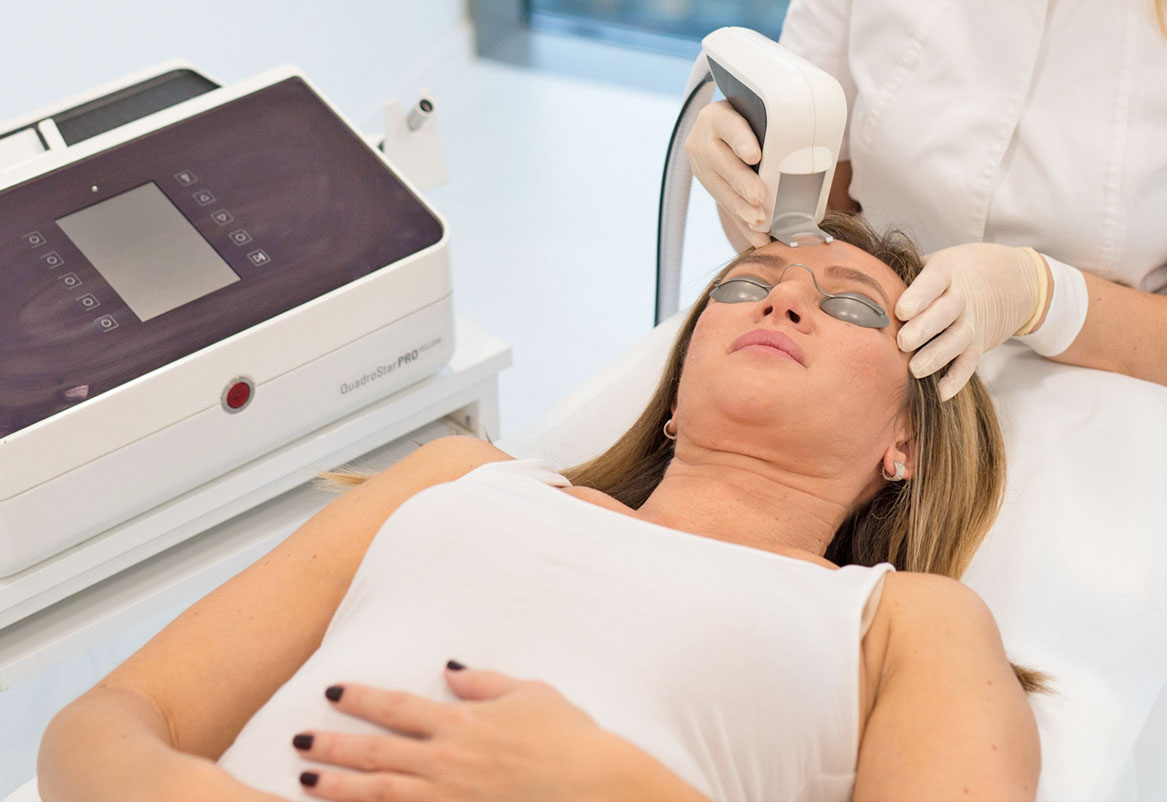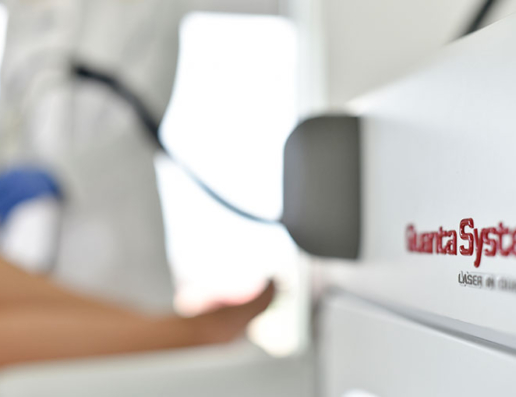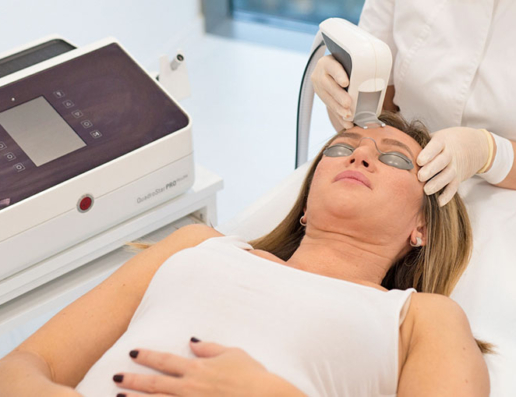Aesthetics
Face
The most modern facial treatments help you look younger, more elegant and happier.
Body
Feel comfortable in your body and correct sources of discomfort.
Chest
Make your wish for a better appearance come true and restore your self-confidence with aesthetic correction.
Hair and scalp
Minimally invasive solutions for hair loss and a natural look.
Issues
Find solutions to some of the most common aesthetic problems.
Treatments
Treatments

Hair and scalp mesotherapy

Thinning hair therapy with your own blood

Trichotest – DNA analysis of hair loss and baldness

Hair loss in women – causes and how to prevent it

Hair loss in men – causes and how to prevent it

Alopecia – hair loss
FACE

BODY

Implantology Center
Different methods of solving the problem of missing one or more teeth.
Prosthetics
The most common solution in cases of functional or aesthetic tooth damage.
Aesthetic Dentistry
Harmonious tooth shaping and tooth color correction according to your wishes.
General Dentistry
Modern and timely diagnostics, treatment and dental hygiene are the key to the health of your teeth.
Issues
Find solutions to some of the most common aesthetic problems.
About us
Locations
Description of the procedure
The appearance of facial redness, couperose or rosacea, can greatly affect the quality of life of those affected by it. Although their condition is chronic, meaning there is no cure, there are certain steps that can be taken to prevent or alleviate the symptoms.
What causes reddening of the face, bursting of capillaries, i.e. couperose and rosacea?
All of the above are caused by both external and genetic factors. Darker skin with normal or slightly increased sebum production is less likely to fall victim to facial redness due to its increased insulation, while thinner, lighter skin is more susceptible. People with thin skin or those with skin with poor capillary wall elasticity are more likely to develop couperose.
Before each treatment, during a consultation, our dermatovenerology specialists will examine you in detail and perform a professional analysis of your facial skin, based on which they will propose a treatment and therapy plan.
What can cause facial redness?
-
Extreme and sudden temperature changes
A sudden change in temperature, such as going from a cold outdoor environment to a warm indoor space, can cause blood vessels in the face to dilate, resulting in redness. Also, exposure to very cold or hot weather can irritate the skin and worsen redness, especially in people with sensitive skin or skin conditions like rosacea.
-
Sun exposure
Prolonged or intense exposure to the sun's rays can lead to skin redness, which is often accompanied by inflammation or sunburn. UV radiation damages the skin and can worsen existing conditions, and also increases the risk of developing skin diseases such as rosacea and skin cancer. People with fair skin are particularly susceptible to this factor.
-
Stress
Prolonged or intense exposure to the sun's rays can lead to skin redness, which is often accompanied by inflammation or sunburn. UV radiation damages the skin and can worsen existing conditions, and also increases the risk of developing skin diseases such as rosacea and skin cancer. People with fair skin are particularly susceptible to this factor.
-
Exercise and work in high temperatures
During intense physical activity or working in a hot environment, the body tries to regulate body temperature by increasing blood flow to the surface of the skin, which can cause redness. While this is a natural reaction, when combined with other factors such as dehydration, redness can become more pronounced and last longer.
-
Hot drinks and spicy foods
Drinking hot beverages like coffee, tea, or soup, as well as spicy foods, can stimulate sensory nerves in the mouth and throat, which can then cause reflex dilation of blood vessels in the face. This leads to temporary redness that can be exacerbated in people prone to rosacea or those with sensitive skin.
-
Alcohol and cigarettes
Alcohol causes blood vessels to dilate, which can lead to facial flushing, especially in people who are more sensitive to alcohol or those with rosacea. Regular alcohol consumption can also permanently dilate blood vessels and lead to chronic flushing. Smoking, on the other hand, reduces oxygen flow to the skin and can cause skin damage, which can worsen flushing, especially with long-term smoking.
-
Rough and improper use of skin care products
Using skin care products that are too harsh, such as those with high alcohol, perfume or acid content, can irritate the skin and cause redness. Also, using products incorrectly, such as over-exfoliating or using harsh treatments too often, can damage the skin's protective layer, increase sensitivity and lead to inflammation and redness. Regular exposure to harsh products can damage skin health in the long term and increase the risk of permanent redness.
Laser treatments for removing redness and capillaries on the face at our Polyclinic guarantee minimal risk to clients, are gentle and painless, and provide excellent results.
To treat the aforementioned changes, we use the yellow QuadroStarPRO laser from Asclepion Laser Technologies, which today represents the most modern technology and the best choice when it comes to capillaries, facial redness, couperose and rosacea.
We, at the Bagatin Polyclinic, have recognized the importance of lasers in aesthetic medicine – our experts use as many as 9 lasers to treat almost all aesthetic problems .
The Quanta System Duetto MT Evo laser is ideal for treating veins and capillaries on the body. It combines two wavelengths of the infrared spectrum, which is why it works equally well on small, fine superficial capillaries, as well as on deep, larger vessels in and under the skin.
The result is that veins, which would only be partially heated by one wavelength, close after treatment with this laser and, over the next few weeks, disappear completely.
Whether you want to remove moles, scars or hair, reduce wrinkles, the appearance of hyperpigmentation or capillaries, you can find all the necessary information about treatments and lasers that solve these problems in one place – the guide we have prepared just for you.
Candidates
If you suffer from visible capillaries around your nose and cheeks and facial redness every day, you are a candidate for laser removal with a yellow laser.
Before each treatment, our dermatologists will examine you to see if you are an adequate candidate.
Preparation
No additional preparation at home is required.
At the Bagatin Polyclinic, before the treatment, the skin is thoroughly cleansed with cleansing milk and a tonic for hypersensitive skin, and makeup, creams, oils, or self-tanning products are removed.
The area to be treated must not be exposed to sunlight so that the laser can distinguish redness and capillaries from the rest of the skin during treatment.
Procedure progress
Once the area to be treated has been cleaned, protective goggles are placed over the eyes and the treatment can begin.
In the first part of the treatment, capillaries visible to the eye are removed.
The laser contains a special ‘pointer’ head with a diameter of 1 mm, which is passed over each capillary. When passing over, the laser emits a light pulse that the client feels as a slight burning sensation. The light pulse is converted into heat, and the blood vessel closes and disappears. The fluid surrounding the vessel (tissue containing a high percentage of water) does not absorb the light, so the surrounding skin is not damaged. The veins are immediately “erased” without the formation of a repulsive peliosis (purple spot).
Then follows the second part of the treatment, where a larger laser head is passed over the area where the redness is expressed, which removes the capillaries invisible to the eye. In this way, even the smallest capillaries that can be the cause of rosacea are removed.
Once the entire area has been laser treated, a cold compress is applied to the face to soothe the skin and reduce redness.
The treatment ends with the application of anti-inflammatory cream.
Recovery
Immediately after the treatment, the area exposed to the laser will be slightly red and inflamed.
You can apply a cold compress to the affected area for comfort and to speed up recovery. For most people, their skin will completely calm down overnight and they can use standard skincare products and makeup the next day.
Avoid direct exposure to the sun and tanning beds for at least 10-15 days after treatment, do not apply soap directly to the treated area if your skin has not calmed down, and do not rub your face for the first few days after treatment.
Precautions
Common side effects are redness and swelling of the skin, which does not last longer than 24-48 hours.
Less common side effects include changes in pigmentation and the appearance of scabs. These are very rare and usually last a few days.
After treatment, it is necessary to avoid the sun for at least 10-15 days and use protective creams with SPF 50+.
Price
The offer includes 3 +1 FREE packages.
In cooperation with banks, our Polyclinic provides the option of paying in installments, as well as interest-free payments up to a certain number of installments.
You can check more about payment methods and treatment prices in the current price list of the Bagatin Polyclinic:
They said about us...
Your
Frequently asked questions
Contact us
Contact us with confidence.
By filling out this form, our call center will contact you within 24 hours to arrange your appointment. We keep all information you provide us with in the strictest confidence.
Phone:
E-mail:

















